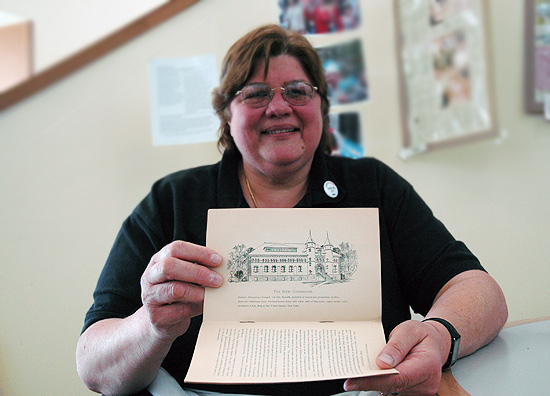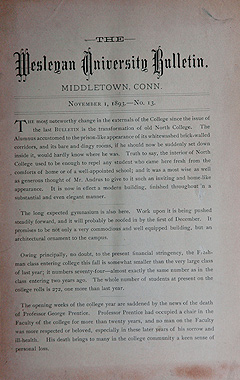Flea Market Find: Wesleyan Circa 1893
 |
| Dining Services employee Vicky Ambro discovered a Wesleyan University Bulletin from 1893 at a flea market in Middletown. The issue announces the opening of the new gymnasium, later named the Fayerweather Gymnasium. |
| Posted 05/01/08 |
 While browsing through a flea market recently, Vicki Ambro came across a tanned paper publication with the words Wesleyan University across the top in an archaic gothic font. While browsing through a flea market recently, Vicki Ambro came across a tanned paper publication with the words Wesleyan University across the top in an archaic gothic font.
It turned out to be a Nov. 1893 issue of The Wesleyan University Bulletin, issue no. 13. I couldnt believe it. It was one of Wesleyans old newsletters and it was in such good condition, says Ambro, who has worked for Wesleyans Dining Services for six years. It really fascinated me. Ambro gently paged through the 16-page publication, browsing Wesleyan news updates on a North College interior renovation; recent faculty appointments; an obituary and biography of Professor George Prentice, who chaired the then Department of Modern Languages; a calendar noting the June 27 commencement; and a department note, stating that seniors will study the literature of the Age of Queen Anne in the upcoming academic year. The Bulletin also featured a section titled Recent Gifts made to the university. This one really made me realize how different things were back then, Ambro says, pointing out an announcement from Ebenezer Hill, Wesleyan Class of 1870. This guy was president of the Norwalk Iron Works and his gift was for $750. Back in 1893, that must have been a years salary. Actually, using a U.S. Federal research cost of living index, it would be equivalent to approximately $17,927.77 in 2008 dollars.But it was an article on Wesleyans new gymnasium now the Fayerweather building that Ambro found most amazing. The Bulletin featured a full-page sketch of the new gymnasium, with its entrance flanked by the iconic massive round towers that stand today. The report mentions that the gymnasium, which cost a total of $60,000 to construct (approximately $1,434,600 in 2008 dollars), would include three bowling alleys, a baseball court, baths, lockers and toilet rooms and a large plunge tank in the basement. The first floor occupied the gymnasium. When completed, it will undoubtedly be one of the handsomest buildings on the campus. When I saw that picture, I told my friend who was with me that, If Im not mistaken, this is the building that is renovated that is right next to the building I work in, Ambro recalls. I decided to buy The Bulletin and bring it into Wesleyan, because it is a piece of history, and this is where it belongs. Ambro paid the market clerk $5 for the Bulletin and shared it with Rick Culliton, university center director and dean of campus programs. Since Wesleyans Special Collections and Archives Department already has a complete Bulletin set, Culliton may add the historic document to the Usdan University Centers Daniel Family Commons display case. According to Valerie Gilipsie, assistant university archivist, The Wesleyan University Bulletin originated in 1888 to secure from alumni and friends a more constant, intelligent, and hearty cooperation in all that pertains to the interests of the college. The Bulletin existed until 1961. I’m not too sure how many Bulletins are still around, but they seem to appear here and there, especially locally, Gillispie says. They may not have much monetary value, but they do, of course, have value for our alumni and others who have a Wesleyan relationship who enjoy seeing historical documents like that. |
| By Olivia Drake, Wesleyan Connection editor |

